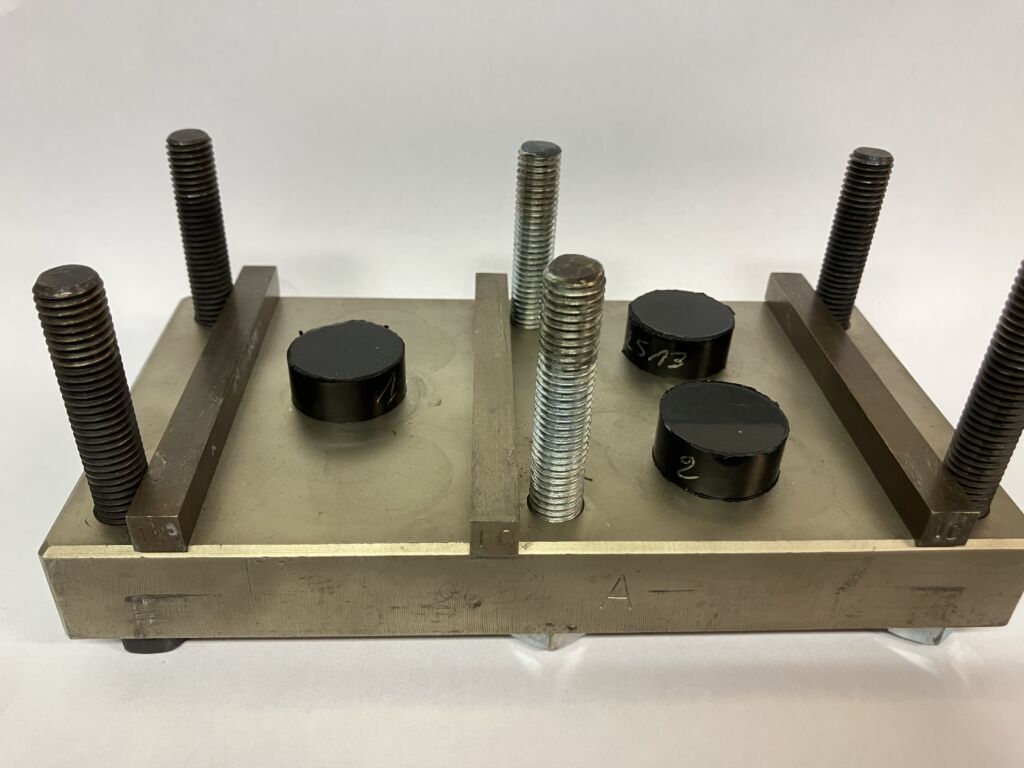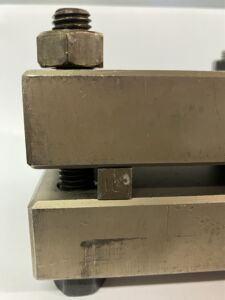When a seal is compressed in its housing, it must be able to return to its original shape as quickly as possible once the stress is removed. It is this ability – essential to the sealing and longevity of systems – that is measured by Compression Set (CS).
Why is COMPRESSION SET (CS) so important?
Rubber is an incompressible but deformable material. In an assembly, the housing is sized to accommodate the deformation of the seal and ensure the pressure necessary for sealing.
However, under the effect of:
- prolonged compression,
- temperature,
- the chemical environment,
- and the age of the material,
the macromolecules reorganise themselves and the seal gradually loses its original elasticity.
➡️ This phenomenon is known as CS: the lower the CS, the better the material retains its spring effect and its ability to provide a durable seal.
CS: a key indicator for your parts
Poor CS leads to:
- a weakening of the seal,
- a loss of preload,
- a reduction in the service life of the assembly,
- risks of functional failure.
At Chevalier-Cleret & Eltec, we formulate and select our elastomers to achieve low compression sets that are suited to your usage constraints.
🌡️ What the CS “model” shows according to temperature and duration
CS is not just a static measurement: it is a test of behaviour over time. By adjusting the temperature and test duration, we simulate different conditions that the seal will encounter in service.
🔥 CS at high temperature: accelerated ageing
When performing an CS at 70°C, 100°C, 150°C, 200°C, etc., we simulate:
- accelerated thermal ageing,
- progressive loss of elasticity,
- degradation of the macromolecular network,
- the effects of several months or years of use on a seal.
➡️ This is clearly accelerated ageing.
❄️ CS at low temperatures (0°C, -10°C, -20°C, -40°C, etc.): behaviour in cold conditions
In cold conditions, the material becomes more rigid and loses some of its molecular mobility. Here, the CS is no longer intended to simulate ageing, but to model functional behaviour in a cold environment:
- stiffening of the material,
- risk of temporary loss of elasticity,
- possible cracking or micro-cracks,
- maintenance of sealing in winter, mountain or aeronautical conditions.
➡️ This makes it possible to assess whether the seal retains sufficient elasticity despite the increased hardness of the material.
📏 How is CS measured? (NF ISO 815-1 standard)
1. Preparation of a test piece (type A or B)
– Type A test piece: cylindrical disc with a diameter of 29.0 mm and a thickness of 12.5 mm

– Type B test piece: cylindrical disc with a diameter of 13.0 mm and a thickness of 6.3 mm
Type A test piece is preferred because its dimensions allow for greater measurement accuracy.
The type B test piece shall be used when it can be taken from a rubber product
2. Compression at a defined rate (often 25%) using a setup comprising two compression plates, stops and a clamping device


The compression plates are made of chrome-plated or stainless steel. They must be rigid and of sufficient size so that the compressed test piece does not protrude.
The steel stops are used to achieve the required compression. Their shape, size and position are adapted so that they do not come into contact with the compressed test piece.

For type A specimens, the height of the wedge is 9.38 mm and for type B specimens it is 4.72 mm to obtain a specimen compression ratio of 25%.
A screw clamping device is suitable, but for low-temperature tests a quick-release system is required.
An oven or cold chamber is required, as appropriate, to maintain the assembly at the required temperature.
3. Maintain under compression for a specified time and temperature.
4. Decompression and measurement of the final thickness after stabilisation.
5. The CS is calculated using the following formula
(H1 – H2) x 100 / (H1 – H3)
H1: initial height of the test piece
H2: final height of the test piece after testing
H3: height of the stop
📊 Common test conditions
Durations: 24 hours, 72 hours, 168 hours, 336 hours, etc.
Normal temperature: 23°C ± 2°C
Examples according to material:
NBR: ~100°C
Silicone/FKM: ~200°C
➡️ A CS < 20% after 70 hours is a good result for a functional seal.
📈 Typical CS values with time + temperature (70 hours – recommended conditions)
| Elastomer | Test time | Test temperature | Typical CS (%) | Comment |
| Silicone HTV | 70 hours | 200°C | 10 – 25 | High heat resistance |
| LSR silicone | 70 h | 200°C | 8 – 20 | Network homogeneity → better CS |
| FKM (fluoro) | 70 h | 200°C | 10 – 25 | High thermal resistance |
| NBR (nitrile) | 70 h | 100°C | 15 – 35 | Sensitive to compression and oils |
| EPDM | 70 hours | 125°C | 10 – 30 | Good chemical and UV resistance |
| CR (chloroprene)) | 70 h | 100°C | 25 – 45 | More sensitive to thermal ageing |
The values shown correspond to tests carried out in accordance with NF ISO 815-1 and represent reference conditions. They enable the CS of different materials to be compared and their behaviour under prolonged compression to be understood.
📈 How can CS be improved?
The CS can be optimised in several ways:
✔️ 1. Through formulation
- Adjusting the cross-linking rate and system,
- Selecting polymers with better thermal stability,
- Adding suitable reinforcing fillers,
- Optimising the ratio of plasticisers and additives.
➡️ A well-designed formulation can reduce CS by 30 to 50% compared to a standard formulation.
✔️ 2. Through the process
- Post-vulcanisation baking (post-curing):
eliminates volatiles → significant reduction in CS for silicone, FKM, EPDM. - Control of vulcanisation time and temperature,
✔️ 3. Through the design of the seal
- Optimised profile to limit permanent crushing,
- Adjusted tolerances to ensure the ideal compression rate,
- Choice of geometry allowing good elastic recovery.
✔️ 4. Through validation under conditions of use
- Tests at representative temperatures,
- Compression/decompression cycles,
- Additional accelerated ageing.
➡️ Improving CS therefore depends as much on the material as on the process, design and functional validation.
🔍 Our commitment to quality
In our laboratory, we regularly check:
- the CS of our own formulations,
- the CS of purchased materials,
- CS ageing according to your specific conditions of use.
Our goal: to guarantee the reliability of the silicone and rubber parts we produce for you.
📩 Need technical support or CS testing for your application?
🔗 Our R&D, laboratory and testing teams are at your disposal.

